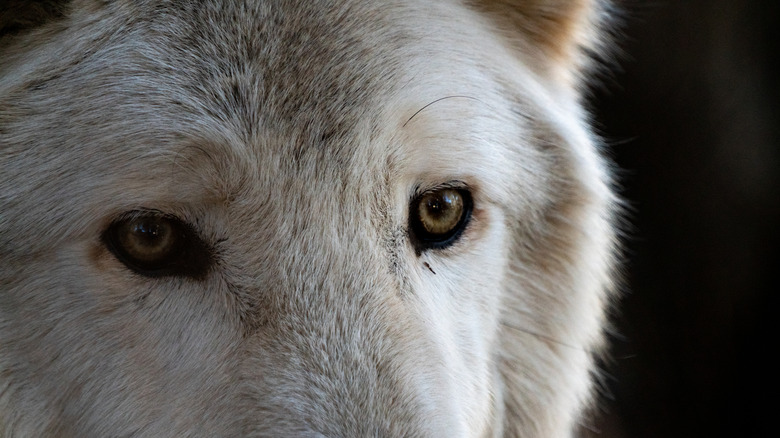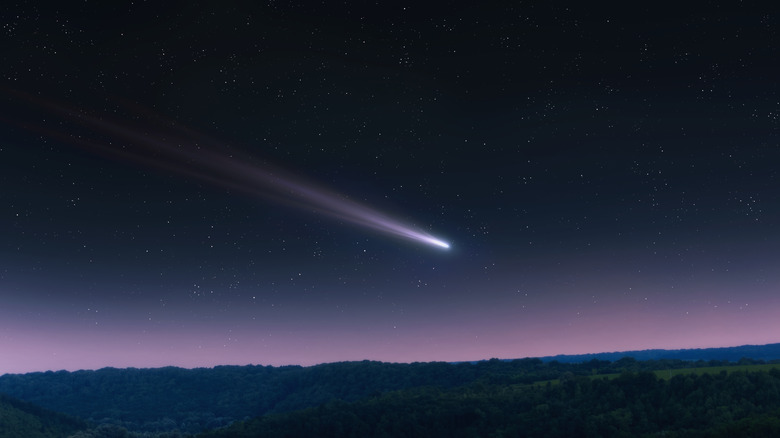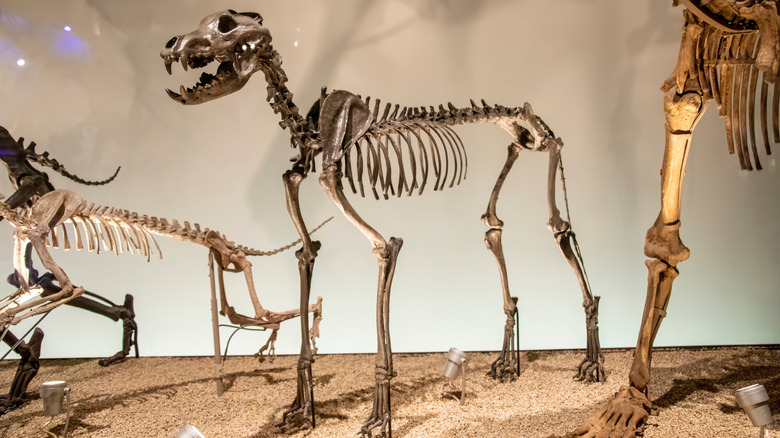The Best Theories So Far For Why Dire Wolves Tragically Went Extinct
The scientific world was rocked on Monday by the announcement that an American biotechnology and genetic engineering company had revived the dire wolf species, which went extinct over 12,500 years ago. Colossal Biosciences announced in a press release that it had successfully bred three dire wolf pups by modifying the DNA of gray wolves and using it to create embryos which were implanted into surrogate female dogs. All told, the team made 20 edits to the gray wolf genome in order to make it match DNA extracted from dire wolf fossils.
The project has proven highly controversial, with many scientists arguing that the pups produced by Colossal are not true dire wolves at all, but rather a designer gray wolf. The company itself acknowledges that it is impossible to create an animal that is 100% genetically identical to a dire wolf, but their pups, named Romulus, Remus, and Khaleesi (the last a nod to "Game of Thrones," which made dire wolves a cultural phenomenon), do have the key characteristics. Their fur is white, their jaws are extremely muscular, and they are likely to grow larger than gray wolves do.
Romulus, Remus, and Khaleesi live on a preserve, but Colossal has expressed an interest in introducing their "dire wolves" into the wild at some point. This could be a very risky move. However, because nobody is entirely sure why dire wolves went extinct in the first place, there has been significant debate over the matter, and a few theories have come to the forefront.
Did humans kill the dire wolves?
Whether by hunting, habitat destruction, or the spread of disease, humans have caused several species to go extinct, but it is unclear if this could have been the case with dire wolves. We know of our hand in events like the extinction of the dodo bird and the near extinction of the bison because we can trace through historical records, but dire wolves went extinct long before the invention of writing. Scientists aren't even sure to what extent humans and dire wolves interacted, if at all.
If humans did play a role in the dire wolf extinction, it probably wasn't through hunting them. There would be little incentive for our primitive ancestors to confront a large and powerful carnivore like the dire wolf when they could go after non-predatory animals like mastodons and mammoths, which offer more meat and fewer claws. The real threats from our species to the dire wolves would be the transfer of diseases and the fact that humans competed for much of the same prey as dire wolves. It is possible that we either outcompeted the dire wolves for food or passed along a deadly disease to them, but without more evidence of human and dire wolf interactions, this theory can only be taken with a huge grain of salt.
Did a comet impact obliterate the species?
A small handful of researchers have linked the extinction of the dire wolves to a theorized extinction event known as the Younger-Dryas Impact. The Younger Dryas was a period of cooling temperatures in the Northern Hemisphere that took place approximately between 12,900 and 11,600 years ago, which is around the same time that dire wolves went extinct. It stands out from other periods of global cooling because its onset was extremely fast, taking less than 100 years. Scientists are in disagreement over what caused such a rapid drop in temperature, but one theory pins the blame on a cosmic crash.
The Younger Dryas impact hypothesis (YDIH) proposes that a comet or similar celestial body broke apart over the North American continent 12,900 years ago, causing a mass extinction event that not only wiped out the dire wolves, but also mammoths, mastodons, and the extinct American lion. It's a compellingly dramatic scenario, but of all the theories around the dire wolf's extinction, this one holds the least water.
The YDIH is a fringe theory that a majority of the scientific community refutes. No definitive evidence of such an impact event can be found. The hypothesis emerged from a 2007 paper published in the Proceedings of the National Academy of Science, but subsequent research has failed to replicate that paper's findings. Several rebuttals have been published, even as recently as 2024 in the journal Earth-Science Reviews. It is highly unlikely that the dire wolves went extinct in this way.
Did climate change spell the end for dire wolves?
By far the most widely-accepted theory behind the extinction of the dire wolf pins the blame on climate change that occurred as the Earth experienced sudden swings between hot and cold temperatures that began even before the Younger Dryas, and continued afterwards. Dire wolves, having stockier frames than gray wolves, were specially adapted to hunt very large mammalian prey like horses, bison, and potentially even mammoths. These big mammals saw their numbers drastically drop with climate change, and in the process, dire wolves saw their food supply vanish before them.
If humans did play a role in causing the dire wolf to go extinct, it was most likely by exacerbating this decline in its prey. Humans competed for many of the same prey as dire wolves. Early humans in North America hunted wild horses, camels, and mammoths, all staple prey for dire wolves. With those species already in decline due to climate change, human hunters could be the final nail in their coffin. As large mammals died out across the continent, dire wolves met the deeply tragic fate of slowly starving to extinction.



